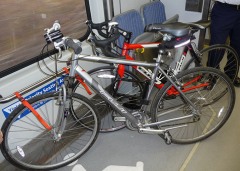
area to increase bike capacity.
(Photos: Jim “K’Tesh” Parsons)
When TriMet’s WES commuter rail line between Wilsonville and Beaverton opened back in January, many bike commuters were concerned about the lack of onboard bike capacity. WES had only two bike hooks per car, compared to four hooks on MAX trains.
One reason for this is because WES, unlike MAX, falls under the “commuter rail” category and as such, is regulated by the Federal Railway Administration (FRA). As TriMet GM Fred Hansen clarified in a TriMet Board meeting where the topic came up in February, “there’s a different set of requirements” for how objects must be secured on commuter rail trains.

TriMet was aware of the problem and they now seem to be testing out a solution. BikePortland West Side correspondent Jim “K’tesh” Parsons noticed Tuesday that TriMet has installed straps in the wheelchair access areas. Parsons found four straps per car, bringing the total bike capacity up to six bikes (as long as the wheelchair areas are not in use).
TriMet’s website still says (in bold letters), “If both racks are occupied, you must wait for the next train,” but I have now learned updated information from TriMet’s Carolyn Young. She said this is a pilot project.
“The straps will be evaluated to determine how well this works for our riders and to test the durability of the straps,” she wrote via email. Young also wrote that, while bikes must yield the space to riders with disabilities, she doesn’t think there will be much conflict given the current number of riders on WES. “However,” she added, “if we do see more mobility devices on the trains we will need to take a new look at this.”

